Intel Core i7-10700 vs Core i7-10700K Review: Is 65W Comet Lake an Option?
by Dr. Ian Cutress on January 21, 2021 10:30 AM EST- Posted in
- CPUs
- Intel
- Core i7
- Z490
- 10th Gen Core
- Comet Lake
- i7-10700K
- i7-10700
CPU Tests: Legacy and Web
In order to gather data to compare with older benchmarks, we are still keeping a number of tests under our ‘legacy’ section. This includes all the former major versions of CineBench (R15, R11.5, R10) as well as x264 HD 3.0 and the first very naïve version of 3DPM v2.1. We won’t be transferring the data over from the old testing into Bench, otherwise it would be populated with 200 CPUs with only one data point, so it will fill up as we test more CPUs like the others.
The other section here is our web tests.
Web Tests: Kraken, Octane, and Speedometer
Benchmarking using web tools is always a bit difficult. Browsers change almost daily, and the way the web is used changes even quicker. While there is some scope for advanced computational based benchmarks, most users care about responsiveness, which requires a strong back-end to work quickly to provide on the front-end. The benchmarks we chose for our web tests are essentially industry standards – at least once upon a time.
It should be noted that for each test, the browser is closed and re-opened a new with a fresh cache. We use a fixed Chromium version for our tests with the update capabilities removed to ensure consistency.
Mozilla Kraken 1.1
Kraken is a 2010 benchmark from Mozilla and does a series of JavaScript tests. These tests are a little more involved than previous tests, looking at artificial intelligence, audio manipulation, image manipulation, json parsing, and cryptographic functions. The benchmark starts with an initial download of data for the audio and imaging, and then runs through 10 times giving a timed result.
We loop through the 10-run test four times (so that’s a total of 40 runs), and average the four end-results. The result is given as time to complete the test, and we’re reaching a slow asymptotic limit with regards the highest IPC processors.

Google Octane 2.0
Our second test is also JavaScript based, but uses a lot more variation of newer JS techniques, such as object-oriented programming, kernel simulation, object creation/destruction, garbage collection, array manipulations, compiler latency and code execution.
Octane was developed after the discontinuation of other tests, with the goal of being more web-like than previous tests. It has been a popular benchmark, making it an obvious target for optimizations in the JavaScript engines. Ultimately it was retired in early 2017 due to this, although it is still widely used as a tool to determine general CPU performance in a number of web tasks.
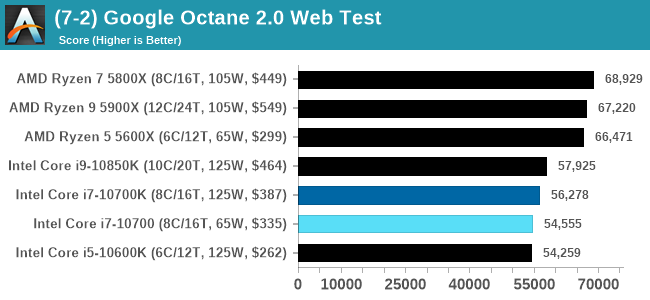
Speedometer 2: JavaScript Frameworks
Our newest web test is Speedometer 2, which is a test over a series of JavaScript frameworks to do three simple things: built a list, enable each item in the list, and remove the list. All the frameworks implement the same visual cues, but obviously apply them from different coding angles.
Our test goes through the list of frameworks, and produces a final score indicative of ‘rpm’, one of the benchmarks internal metrics.
We repeat over the benchmark for a dozen loops, taking the average of the last five.
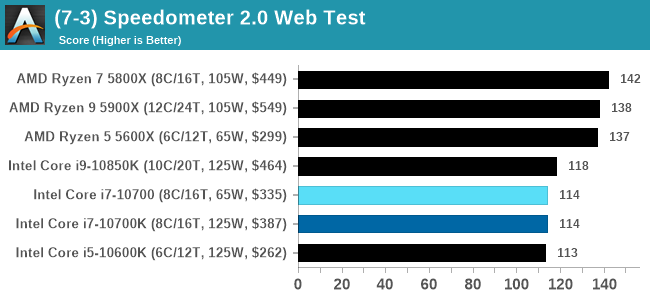
Legacy Tests
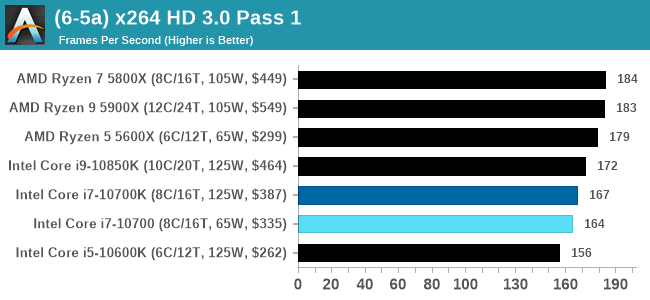
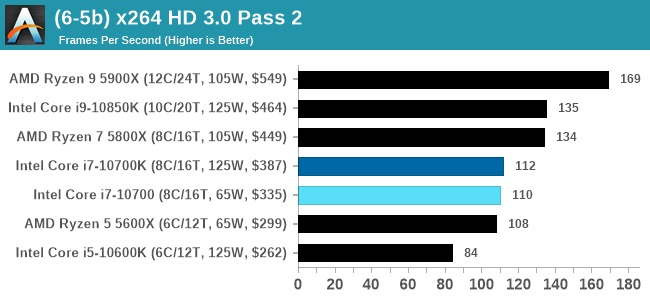
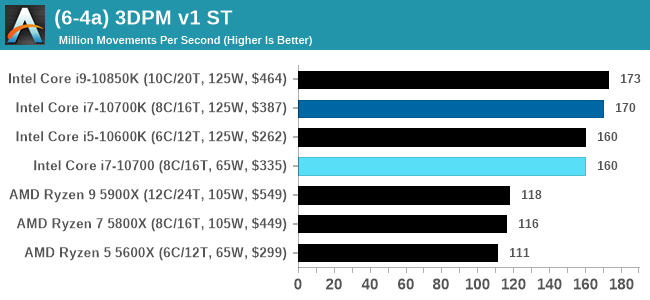
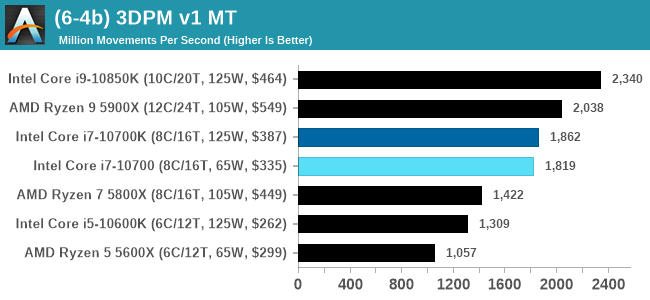
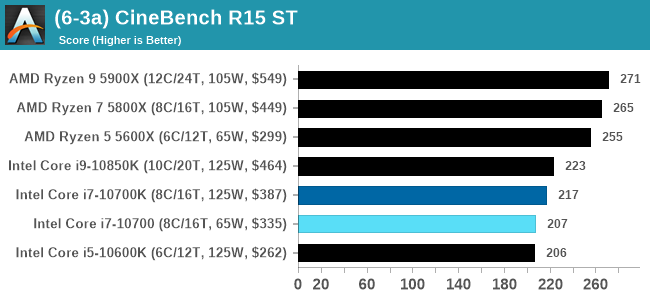
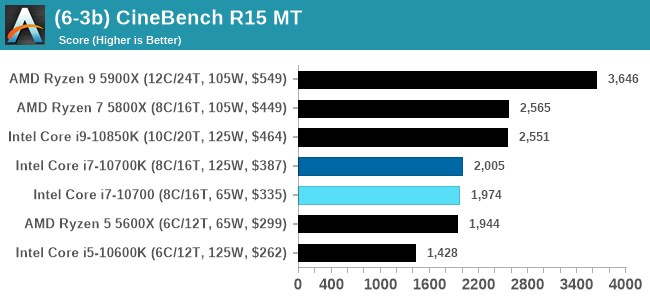


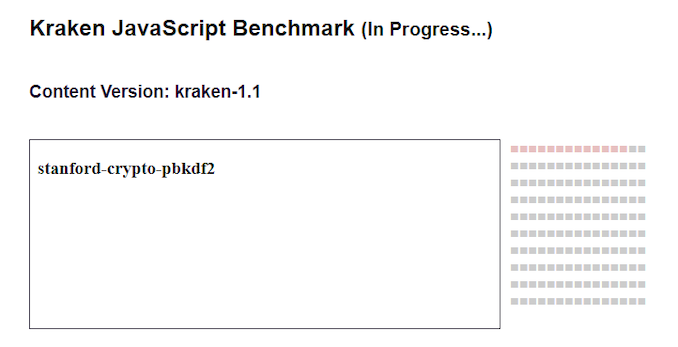
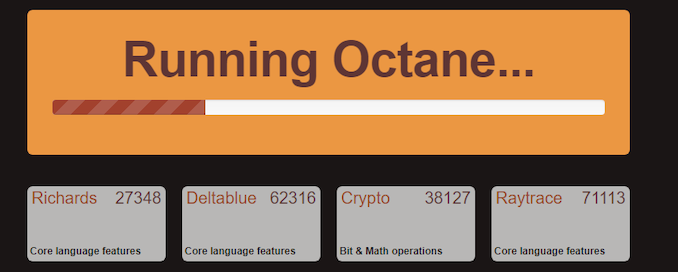
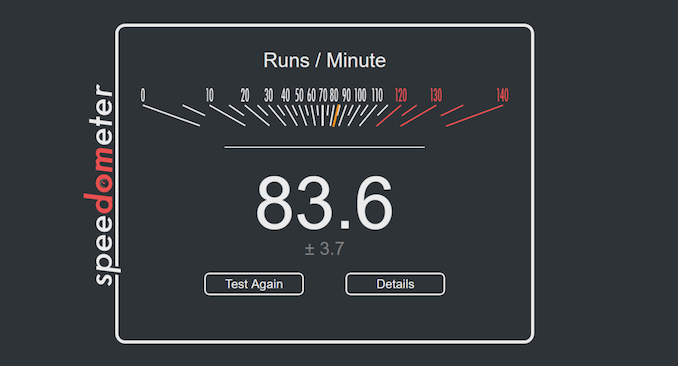








210 Comments
View All Comments
alexane - Sunday, January 24, 2021 - link
easy job online from home. I have received exactly $20845 last month from this home job. Join now this job and start making extra cash online. salary8 . comMilaEaston - Tuesday, January 26, 2021 - link
easy job online from home. I have received exactly $20845 last month from this home job. Join now this job and start making extra cash online. salary8 . com
flyingpants265 - Friday, January 22, 2021 - link
Right. I'm not even sure why this is an issue. TDP stands for "thermal design power", it's how much power the chip uses, it's not debatable.etal2 - Thursday, January 21, 2021 - link
What I'm missing from this review is a benchmark running under intels recommended settings.From what I've seen often people see the 65w rating and go on to combine the i7-10700 with cheap B460/H470 motherboards and basic coolers.
Duraz0rz - Thursday, January 21, 2021 - link
The problem here is that the turbo limit is not enforced by the chip, but by the mobo. So even cheap B460/H470 boards can set that limit to be higher than Intel's recommendations if they choose to. And no one that would be buying these boards will necessarily care to dig into the BIOS and set the limits themselves.Cygni - Thursday, January 21, 2021 - link
Yes, they would. There are lots of (admittedly niche) applications where outright sustained performance is less important that bursty performance in a limited thermal envelope, either due to space or ventilations issues. HTPCs, home servers, small industry applications, etcSo yeah, i agree with the OP, I would have liked to have seen performance numbers at the "suggested" 65w PL1.
Calin - Friday, January 22, 2021 - link
I totally agree with your comment, but what you ask for is a different article.Performance numbers in a strictly power limited environment - from Intel and AMD both (although Intel will be unfairly penalized by being three or so lithography generations behind).
Spunjji - Friday, January 22, 2021 - link
"unfairly penalized"The product you test is the product they have on sale - that's not unfair in the context of a test designed to represent a specific real-world requirement.
olde94 - Monday, January 25, 2021 - link
yeah i never heard anyone saing that amd was "unfairly penalized" in 2015. they could just "suck it up"Spunjji - Monday, January 25, 2021 - link
To be fair, some people did (GloFo's 28nm is terrible, I don't care about power, etc.) and I had no time for them either.